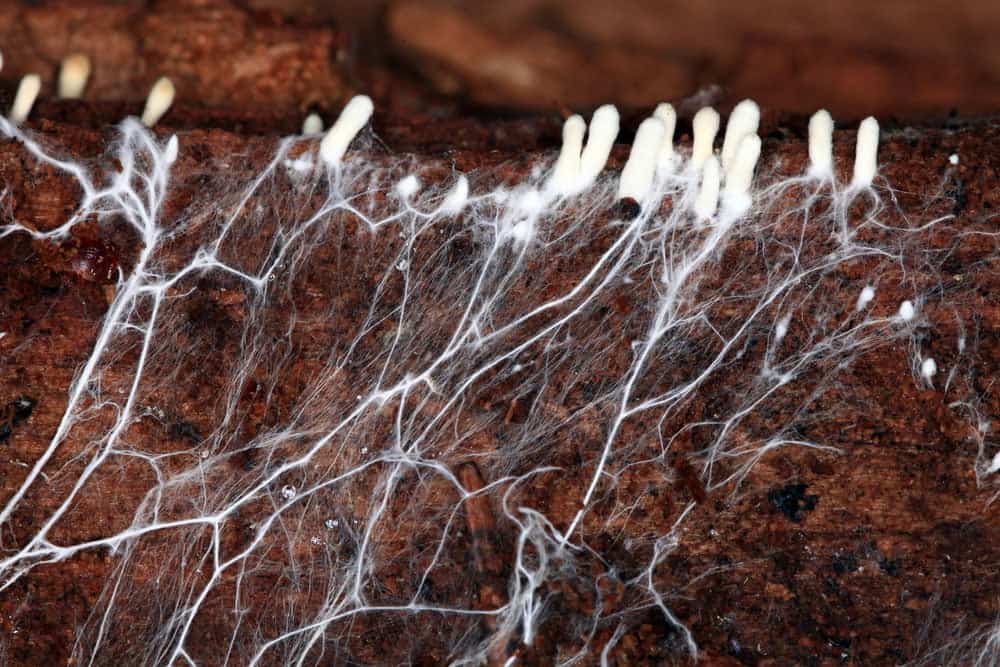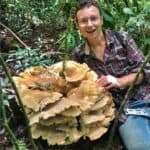Table of Contents
Growing mushroom mycelium is an integral part of mushroom cultivation. It is most often grown by cloning it from one growth medium to another. Mushroom mycelium can also be grown from spores. Contrary to the belief of some, growing mushroom mycelium is quite easy!
Mushrooms are the Tip of the Iceberg
Anatomically speaking, Mushrooms are only the “tip of the iceberg”. They are only the reproductive structure of a larger and more complex organism.
Mushroom-producing fungi are, by volume and mass, mostly composed of a filamentous mycelium. Mycelium looks like a web-like branching network of white fungal strands. You’ll most see mycelium in nature under leaf litter, rotting logs, and even sometimes in the soil. Only once matured will this mycelium begin producing mushrooms.
Growing Mushroom Mycelium
Growing mushroom mycelium can be an easy process. It’s important if you wish to cultivate mushrooms, but it’s done for other purposes as well.
Reasons to grow Mycelium
- Production of Edible and Medicinal Mushrooms
- Production of Biomaterials
- Production of Medicinal Mycelium Products
- Breeding of Mushroom Species
- Production of Mushroom Spawn
- Isolation of Species on Petri Plates
- Bioremediation
- Edible Mycelium
Where does Mycelium come from?
Mycelium is unlike any other form of life. It grows within substrates that act as their home and food source. Substrates are the natural materials that fungi inhabit. Common substrates are wood, straw, grain, cardboard, and organic waste.
- Mycelium Can Come From Mycelium
Every fungal cell has the ability to become its own individual fungal network. This makes it easy to “clone” fungi by introducing mycelium into a new substrate. This can be done with spawn, liquid culture, or fresh fruiting bodies.
Or
- Mycelium Can Grow From Spores
Spores are the reproductive cells of the mushroom. They only contain 50% of the genetic information from their parent. Because of this, they are more like pollen than seeds.
For cultivation, growers germinate spores in Petri dishes. Cultivation of mycelium via spores is an advanced technique. This usually requires lab equipment and skill. For beginners, it is much better to start with a clean and healthy mycelium culture.
Growing Mycelium from Mushroom Spawn
Using Mushroom Spawn is the best way to start growing mushroom mycelium. It requires little experience and no fancy equipment. This method works particularly well for the cultivation of Oyster Mushroom mycelium.
What is Mushroom spawn?
Mushroom spawn is mycelium, usually grown on grain and used for inoculation. Inoculation is the process of introducing mycelium into a new growth medium. High-quality mushroom spawns should grow vigorously and be free of any contaminants.
Equipment needed:
- Substrate (Straw, Wood, Coffee Grounds, Leaves, Grains, etc.)
- Mushroom Spawn
- Mushroom Grow Bags or Alternative Vessels
- Large Pot or Barrel for Pasteurization
- 70% Alcohol
- Get High-Quality Mushroom Spawn
This is one of the most important steps. If your spawn is no-good, then it complicates the rest of this process! Find a trusted source. - Prepare Your Materials and Workspace
Make sure all your equipment has been well cleaned and rubbed down with 70% alcohol. It’s good to have a clean surface such as a table to work on. Some growers prefer to wear gloves during the process. Your workspace should be within a closed room, but this is not necessary. - Pasteurize Your Substrate
Pasteurization is a process in which you remove antagonistic microorganisms from your substrate. There are many ways to pasteurize your substrate. The easiest is by submerging your substrate in water for 1 hour at 160F. Alternatively, submerge your substrate in a 0.2% activated lime water for 12 hours. After pasteurization, place your substrate to drain and cool down. - Inoculate With Spawn
Do this by mixing your treated substrate with spawn. You can do this within special grow-bags, but also in buckets or other vessels. Make sure there is an air filter that allows for fresh air exchange (these are already present in grow bags). Your final mix should only contain between 4-8% spawn.
If producing biomaterials, inoculate your mushrooms within a specialized mold. Make sure it has air exchange and proper growing conditions!
- Incubate
This means letting it grow! It is best to incubate in dark places with cool temperatures. A room between 65-75F with 80% humidity is ideal. Make sure there is also plenty of fresh air! Your mycelium should colonize the substrate within 3-4 weeks! Once your mycelium has covered your substrate, it should look almost entirely white! If you start seeing fruiting bodies, then you know it’s likely reached the end of its growth stage. After this, you will have successfully grown mushroom mycelium!
If you choose to you can fruit your mushrooms. Do this by place your mycelium in a room humid environment (ideally >90%) and wait for the mushrooms to form! If you are making biomaterials, dry your mycelium before it becomes contaminated!
Other ways to grow Mycellium
Mycelium can also be grown without spawn. The downside is that these methods often need technical experience and laboratory equipment.
Growing Mushroom Mycelium in liquid Culture
Mycelium can also grow in a liquid medium. You can do this with basic equipment and the proper technique. In most cases, you grow mycelium within a sugar-water solution inside a jar. This jar has a special lid that with a “self-healing injection port”. With this, you can inoculate your liquid culture into new growth mediums with a syringe.
Growing Mushroom Mycelium on Cardboard
You can easily grow mycelium on cardboard. Take your source of mycelium, whether it’s spawn or a mushroom, and break it into little pieces. Place this into cardboard that has soaked in a 0.6% (3ml to 500ml) hydrogen peroxide solution. Keep your cardboard in a plastic bag and watch it grow! Make sure to leave the bag slightly open for fresh air exchange.
Growing Mushroom Mycelium in a Petri Dish
Experienced individuals who work with fungi do so in Petri dishes. This is because within a petri dish you can have better control of the organisms living within it. This can be particularly useful for the isolation of specific fungal species. For example, when cloning mushrooms from the wild or when germinating spores. This y requires technical knowledge and laboratory equipment.

